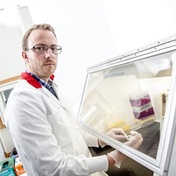The findings are the latest in a flurry of published research that seeks to duplicate embryonic stem cell behaviour and biology while sidestepping the political and ethical obstacles associated with their use.
"The ability to make a pluripotent stem cell from an individual without the ethical and immunological problems associated with human embryonic stem cells is a big deal," said Peter J. Donovan, a stem cell expert at the University of California, Irvine.The new research was published online October 8 in the journal Nature.
How it was done
Thomas Skutella of the University of Tubingen in Germany and his colleagues used testicular tissue from 22 men to create what they call "germline stem cells". Essentially, they collected these tissues, isolated the cells that give rise to sperm cells, and then cultured them in growth media containing factors that support the development of human embryonic stem cells. Within a few weeks, the cells took on many of the genetic and growth characteristics of embryonic stem cells.
At the genetic level, for instance, the new cells were more like embryonic stem cells than sperm cells. When injected into immune-compromised mice, they produced teratomas, a tumour that contains many different kinds of cells. When grown in culture dishes, the new cells could be directed to differentiate into muscle, bone, neurons, and pancreatic tissues, the study authors said.
"My summary is, it is a nice paper, they made big progress in getting to a pluripotent cell, and they show pluripotency with a teratoma experiment," said Dr Gerd Hasenfuss of the University of Gottingen, Germany, who has published papers on converting mouse sperm cells into stem cells.
Not there yet
"But I think we are not completely there where we want to be," he added, "namely at pluripotency absolutely comparable to that of embryonic stem cells." In particular, he noted that the study authors failed to show creation of cells called cardiomyocytes, which cause heart muscle to beat.
The new study is the latest in a string of related work on creating embryonic-like stem cells. Researchers and clinicians alike are excited by the potential of embryonic stem cells because they are "pluripotent," meaning they can create any cell type in the body. Most adult cells, in contrast, if they can divide at all, can only create cells of the same type - that is, a dividing skin cell can only create another skin cell. So, embryonic stem cells could be used to create new tissues for transplantation, say, or to study how genetic mutations cause development to go awry.
The problem, of course, is that to obtain embryonic stem cells, an embryo must be destroyed - a process fraught with ethical and political difficulty. Recently, researchers sidestepped this problem by turning back the clock on adult mouse and human "somatic" cells, such as skin cells, to make them behave as if they were embryonic. The trick is to introduce four genes into the cell you want to reprogramme, creating so-called induced pluripotent stem (iPS) cells.
Originally, iPS cells were created using modified retroviruses or lentiviruses - the same type of virus that causes Aids, for instance. But this type of virus inserts its viral genetic material into the host cell's chromosomes, causing mutations, which effectively made the process a non-starter for clinical work.
Two weeks ago, a team at Harvard described a way to accomplish the same thing using viruses that skip this genetic integration step, theoretically making the process safer.
Avoiding genetic manipulation
Now Skutella and his team have demonstrated similar results while avoiding genetic manipulations altogether; instead, the reprogramming is induced by changing the cells' growth conditions.
What these authors accomplished, said Hasenfuss, was "to get a pluripotent cell out of the spermatogonial [sperm] stem cells without the need of gene transfer requiring viruses."
Skutella and his colleagues aren't the first to reprogramme testicular cells; others have already done so in mice. But his team was the first to successfully do so in humans, said Dirk de Rooij, emeritus professor of endocrinology at Utrecht University in the Netherlands, who recently wrote a review on reprogramming mouse spermatogonial stem cells.
De Rooij called the new study "a breakthrough."
"In comparison to the mouse studies that have been done, there is a big leap forward in efficiency with which these people get these germline stem cells," he said.
But besides the obvious fact that women can't benefit from this development, Donovan, who called the study "an exciting piece of work," raised one additional question that may limit the technique's adoption: "I suspect people would be much more willing to give up a piece of skin to make an iPS cell than to have a testicular biopsy to give rise to an adult germline stem cell," he said. – (Reuters Health)
Read more:
Safer way to make stem cells
Another stem cell breakthrough?
October 2008




 Publications
Publications
 Partners
Partners










